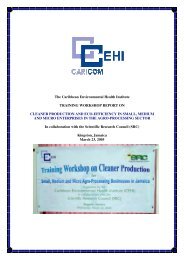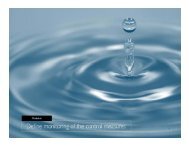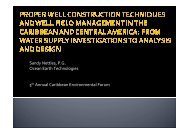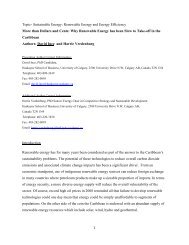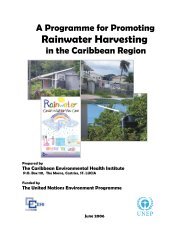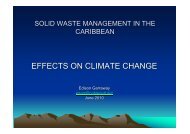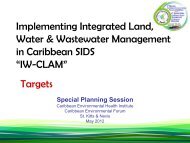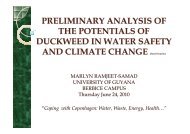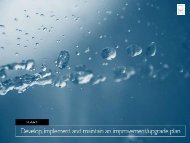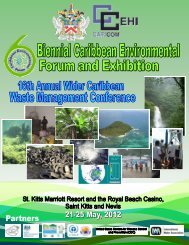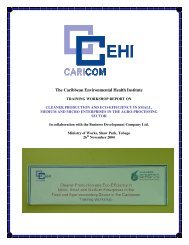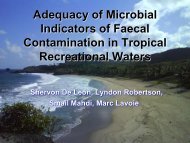conference magazine - Caribbean Environmental Health Institute
conference magazine - Caribbean Environmental Health Institute
conference magazine - Caribbean Environmental Health Institute
Create successful ePaper yourself
Turn your PDF publications into a flip-book with our unique Google optimized e-Paper software.
The aim of this paper was to assess the impact of the service age of<br />
pipes on the chlorine wall decay constant. One hundred and fifty<br />
three pipe sections of different sizes and four different pipe materials<br />
were collected and tested for their chlorine first-order wall decay<br />
constants. The results showed that pipe service age was an important<br />
factor that must not be ignored. For the range of the 55 years of<br />
pipe service age used in this study, the change in the wall decay<br />
ranged from 8% to 531% of the corresponding values in the recently<br />
installed pipes. The effect of service age on the wall decay constants<br />
was most evident in steel pipes. Other important findings were<br />
reached.<br />
Development of the St. Lucia Recreational Water Quality Standards<br />
by Alexandra DuBoulay<br />
The importance of establishment of recreational water quality standards<br />
is against the backdrop of increasing threats to the coastal<br />
environment largely through land-based sources of marine pollution.<br />
The threat from pollution has significant implications not only to the<br />
health and well-being of the citizens of Saint Lucia but serves to<br />
degrade the tourism product, which is the primary economic driver of<br />
the country. Based on the findings and consultative process in this<br />
study it was recommended that ‘Guidelines’ be developed that<br />
should be translated into a more ‘prescriptive’ Standard. The development<br />
of the guidelines for recreational water quality for St. Lucia<br />
involved various components including public sensitization activities,<br />
technical consultations, field visits, meetings with resource personnel,<br />
public and institutional perception surveys and literature reviews.<br />
To inform the development of the guideline, local stakeholder input<br />
was solicited. This was done on two levels: (1) through national<br />
consultations when a series of four events were hosted in which<br />
participants were sensitized on the initiative, who in turn offered<br />
suggestions on what the components of the guidelines should<br />
include, and (2) through island-wide surveys of individuals and businesses/institutions<br />
to obtain inputs on perceptions associated with<br />
the definition, use and management of recreational waters. A monitoring<br />
framework is also proposed as part of the guidelines. The<br />
guideline presented in this study is intended to be used as the basis<br />
for the actual development of the standard. It is recommended that<br />
the process be channelled through the national standards-setting<br />
body, the St. Lucia Bureau of Standards. It is recommended that the<br />
legislative provisions of relevant front-line agencies incorporate references<br />
to the recreational water quality standard so as to expand<br />
institutional support to ensure compliance to the standard. The<br />
guideline document developed by CEHI can be used to ensure that<br />
recreational water in St. Lucia meets the desired quality.<br />
Connections between Land Use Changes and Water Quality in a<br />
Subtropical Urban Coastal Watershed in Florida, USA by Gurpal<br />
S. Toor<br />
Eutrophication is a broad term used to describe enhanced phytoplankton<br />
growth in water bodies that receive excess nutrients such<br />
as nitrogen (N) and phosphorus (P) from various land uses in a watershed.<br />
In the US and elsewhere, eutrophication is one of the<br />
greatest threats to the coastal economies and health of the estuaries.<br />
Further, the impact of land use changes on water quality especially<br />
in coastal tropical and subtropical areas is of immense interest.<br />
This interest stems from dependence of coastal economies on open<br />
water for fisheries and recreational purposes. In rapidly developing<br />
coastal urban communities such as those in the <strong>Caribbean</strong> and Florida,<br />
solutions that are protective of water quality while allowing future<br />
development are urgently needed. Unfortunately, most land use<br />
modification decisions lack scientific rigor which further complicates<br />
the impact of such changes on water quality of receiving water<br />
bodies.<br />
Recent research has suggested that controls on both N and P transport<br />
from land to water might be needed to control eutrophication in<br />
freshwater-marine continuum. Therefore, the inputs of N and P are<br />
greater in human dominated land uses (agricultural and urban) as<br />
compared to relatively undeveloped land areas such as natural forests.<br />
The nutrient sources can be divided into “point sources” such<br />
as wastewater and industrial effluents and “non-point sources” such<br />
as runoff and leaching from urban and agricultural areas. Non-point<br />
source pollution is dominant in most of the watersheds in the US and<br />
elsewhere. Urban storm water runoff is the major contributor of<br />
nutrients to coastal water bodies in developed and rapidly developing<br />
regions.<br />
Florida is one of the rapidly developing states in the US and has<br />
serious water quality problems such as eutrophication of coastal<br />
waters. Therefore, it is important to assess the impact of anthropogenic<br />
activities on water quality of coastal waters. This presentation<br />
will discuss how the land use changes in an urban coastal area, the<br />
Alafia River Watershed (drainage area: 1085 km 2 ) that drains into<br />
the Tampa Bay estuary, has impacted the water quality. This watershed<br />
represents a typical urbanizing watershed in the region with a<br />
diverse mix of urban, agricultural, and mixed land uses. The presentation<br />
will specifically address how the different land uses have<br />
impacted losses of various organic and inorganic forms of N and P<br />
from 1991 to 2009.<br />
The presentation will conclude with an optimized water quality monitoring<br />
approach and synthesis of best management practices that<br />
rapidly urbanizing communities in Florida and <strong>Caribbean</strong> countries<br />
can use to assess the impacts of land use changes on water quality<br />
and protect their valuable water resources.<br />
Assessing exposure to Persistent Organic Pollutants (POPs) in<br />
the <strong>Caribbean</strong> by Martin Forde and Eric Dewailly<br />
Persistent organic pollutants (POPs) have become widespread in<br />
the environment and are now widely recognized as a global contamination<br />
problem. Although mapping of the scope and scale of POPs<br />
contamination has begun in most developed countries and is ongoing,<br />
to date, there has been a lack of information concerning the<br />
sources, fates, and effects of these highly toxic, bio-accumulative,<br />
persistent chemicals within the <strong>Caribbean</strong> region.<br />
This lack of information is particularly troubling since it is well known<br />
that many POP chemicals have been extensively used within this<br />
region for agriculture and vector control purposes over several decades.<br />
Since the half-lives of many POPs can be measured in decades,<br />
it is plausible that significant POP chemical concentrations<br />
may still be present in the <strong>Caribbean</strong> environment which continue to<br />
serve as major causes of contamination to the region’s food and<br />
37<br />
A<br />
B<br />
S<br />
T<br />
R<br />
A<br />
C<br />
T<br />
S<br />
FIFTH BIENNIAL CARIBBEAN ENVIRONMENTAL FORUM AND EXHIBITION




